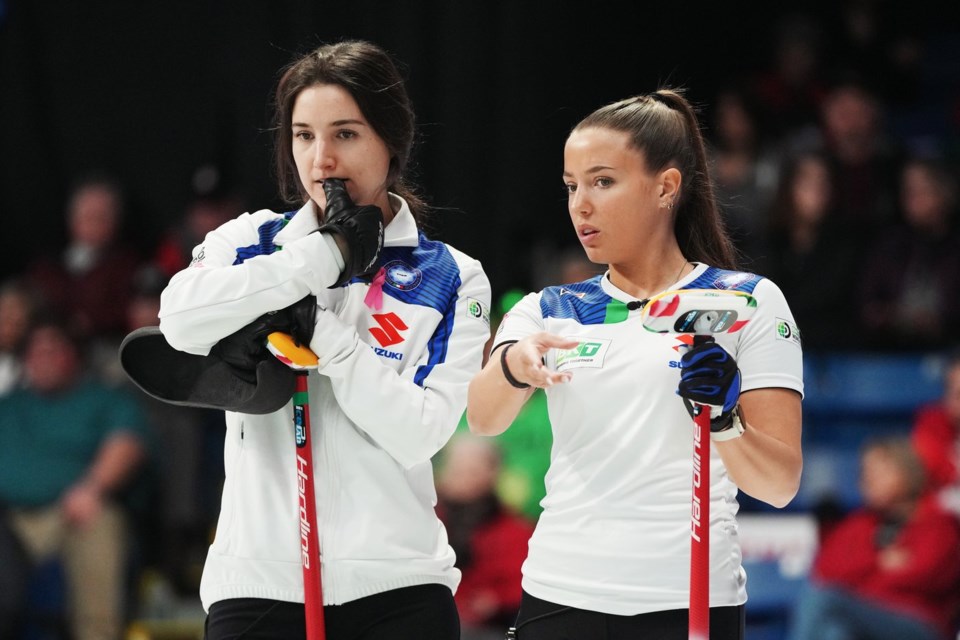When veteran curlers Brad Gushue and Mark Nichols entered the locker room at the Stu Sells Oakville Tankard for their season-opening bonspiel, they were expecting to see many of their usual opponents.
Instead they got a first-hand look at the new generation that's set to make a mark on the Roaring Game.
"We looked around and we didn't recognize a lot of the faces," Gushue said. "A lot of new younger teams are on the scene, especially the international teams."
The September bonspiel wasn't just a one-off for up-and-coming international talent. Many of the men's and women's teams in the field in Oakville are regulars on the top-flight Grand Slam of Curling circuit.
A wave of under-30 talent from abroad -- anchored by skips like Switzerland's Marco Hoesli, Scotland's Ross Whyte, Italy's Stefania Constantini and Sweden's Isabella Wrana, to name a few -- has the sport's future looking bright, but has also exposed a lack of next-gen depth on the Canadian scene.
"The rest of these countries are amazing and they're young, they're kids," said four-time world champion Glenn Howard, who's coaching this season after retiring as a player. "It's not like 40-year-olds are coming over.
"They're 20-somethings with a ton of talent."
Long gone are the days when domestic entries would dominate the entry lists at Slam stops. Canadian teams usually occupy about one-third of the spots with several strong young international rinks joining their veteran peers in the field.
"You don't really need the experience to get to the top anymore," said Swedish skip and reigning Olympic champion Niklas Edin. "You just basically have to have the talent and you've got to put the time in. And then obviously do it the right way."
Edin, who turns 40 next summer, said in addition to quality coaching from experienced curlers, many young players also utilize streaming options and online video to analyze strategy and technique.
"The 22-year-olds of today are probably just as knowledgeable as the 30-year-olds were a decade ago," he said in a recent interview. "I think you can just gather information that much quicker.
"If you're physically able and mentally able, you will get there in no time nowadays."
This week's Co-op Canadian Open in Nisku, Alta., has seven domestic entries on the men's side and five in women's play. The average age of the Canadian skips is 36.9 while it's just 30.4 for the international skips.
Only three Canadian skips are in their 20s: Rylan Kleiter (26), Selena Sturmay (26) and Matt Dunstone, who turns 30 in June. Both Kleiter and Sturmay are playing in a Tier-1 Slam for just the second time.
In addition to Hoesli (24) and Whyte (26), other under-30 men's skips include Switzerland's Michael Brunner (29), Scotland's James Craik (23) and Switzerland's Yannick Schwaller (29).
Joining Constantini (25) and Wrana (27) on the women's under-30 list are South Korea's Seung-youn Ha (24), Japan's Ikue Kitazawa (28), Switzerland's Xenia Schwaller (22) and Japan's Miku Nihira (22).
Howard, who's coaching Team Chelsea Carey this week, said he has noticed that many young international teams have been playing with "no fear."
"I'm watching the strategy and I'm watching the tactics and they don't care," he said. "They're like, 'If I don't make this shot, I'm going to give up four. But I'm going to go make this shot.'
"And they do. It's like, 'Whoa.'"
Curling Canada unveiled a revamped national next-gen program last May to help develop the country's younger talent. It includes U21 national champions, U25 Next-Gen Classic winners and U27 teams in the top 15 of the national rankings.
Selected teams spend two years in the program with funding and support contingent on meeting performance standards and expectations.
Many international rinks, however, have different setups since there are fewer elite teams in those countries. Depending on funding arrangements, many athletes are able to curl on a full-time basis.
It has helped lead to more parity and strengthened the sport as a whole.
"The game is amazing right now," Howard said. "The game has never been so good. It's fun to watch and it's going to be interesting to see where it goes in the next 10 years."
This report by The Canadian Press was first published Nov. 5, 2024.
Follow @GregoryStrongCP on X.
Gregory Strong, The Canadian Press



